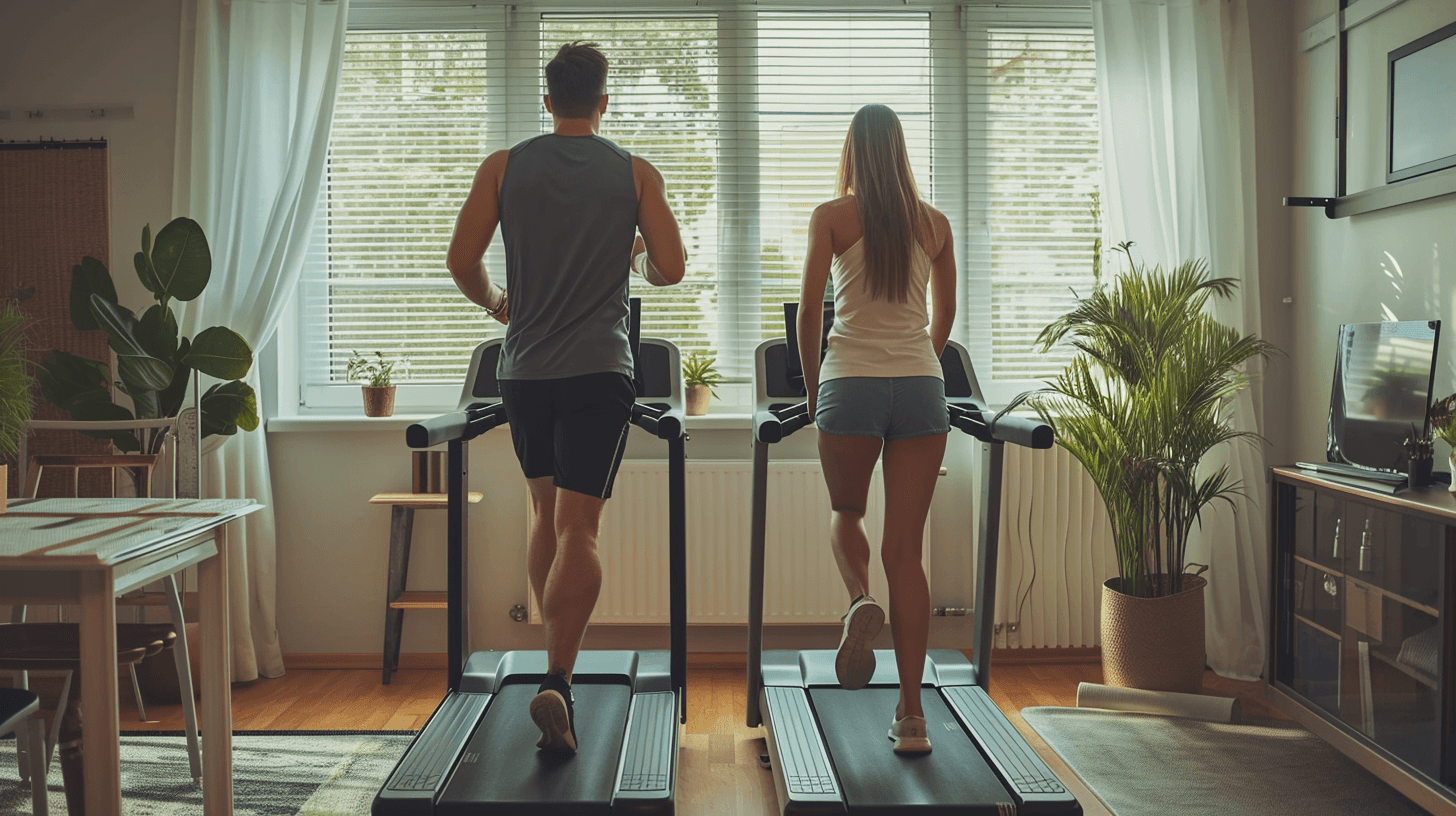Workout
Body Recomposition Workout Plan: Transform Your Physique
Achieve fitness goals with a body recomposition plan combining fat loss and muscle gain. Learn key principles and explore personalized plans with Fit Senpai.
Jun 29, 2024



Introduction
Body recomposition is a transformative process that combines fat loss and muscle gain. It’s perfect for individuals who are serious about optimizing their fitness and achieving a balanced, healthy body. The key to successful body recomposition lies in a strategic workout plan, proper nutrition, and consistency. This blog will explore the essential components of a body recomposition workout plan, provide a detailed guide on how to implement it, and highlight the benefits of this approach. Whether you’re a fitness enthusiast, a gym-goer looking for a new challenge, or a busy professional seeking efficient results, this guide will help you reach your goals.
Introduction
Body recomposition is a transformative process that combines fat loss and muscle gain. It’s perfect for individuals who are serious about optimizing their fitness and achieving a balanced, healthy body. The key to successful body recomposition lies in a strategic workout plan, proper nutrition, and consistency. This blog will explore the essential components of a body recomposition workout plan, provide a detailed guide on how to implement it, and highlight the benefits of this approach. Whether you’re a fitness enthusiast, a gym-goer looking for a new challenge, or a busy professional seeking efficient results, this guide will help you reach your goals.
Understanding Body Recomposition
Body recomposition involves altering your body’s ratio of fat to muscle. This process requires a combination of resistance training, cardiovascular exercise, and a tailored diet to support muscle growth and fat loss simultaneously.
Key Principles of Body Recomposition
Caloric Balance: To lose fat, you need a caloric deficit, but to gain muscle, you need a caloric surplus. Striking a balance is crucial.
Protein Intake: Adequate protein intake is essential to support muscle repair and growth.
Progressive Overload: Gradually increasing the weight or resistance in your workouts helps stimulate muscle growth.
Consistency: Regular workouts and a consistent diet are fundamental to achieving body recomposition.
Creating Your Body Recomposition Workout Plan
Resistance Training
Resistance training is the cornerstone of body recomposition. It helps build and maintain muscle mass while promoting fat loss.
Sample Resistance Training Schedule
Monday: Upper Body (Chest, Shoulders, Triceps)
Bench Press: 3 sets of 8-12 reps
Shoulder Press: 3 sets of 8-12 reps
Tricep Dips: 3 sets of 10-15 reps
Wednesday: Lower Body (Legs, Glutes)
Squats: 3 sets of 8-12 reps
Deadlifts: 3 sets of 8-12 reps
Lunges: 3 sets of 10-15 reps
Friday: Full Body
Pull-Ups: 3 sets of 8-12 reps
Rows: 3 sets of 8-12 reps
Planks: 3 sets of 30-60 seconds
Cardiovascular Exercise

Cardio plays a significant role in burning calories and improving cardiovascular health.
Sample Cardio Schedule
Tuesday: HIIT (High-Intensity Interval Training)
20 minutes of alternating sprints and rest periods
Thursday: Steady-State Cardio
30-45 minutes of moderate-intensity cardio (e.g., jogging, cycling)
Saturday: Active Recovery
Light activities like walking or yoga
Nutrition for Body Recomposition

Nutrition is as crucial as your workout plan. It’s essential to fuel your body with the right nutrients to support muscle growth and fat loss.
Dietary Guidelines
Caloric Intake: Calculate your maintenance calories and adjust slightly based on your goals.
Macronutrient Breakdown: Aim for a balanced diet with adequate protein (1.2-2.2g per kg of body weight), healthy fats, and carbohydrates.
Meal Timing: Spread your protein intake throughout the day to optimize muscle protein synthesis.
Tracking Progress

Tracking your progress is vital to ensure you’re on the right path. Use body measurements, progress photos, and strength improvements as indicators.
Tools for Tracking
Body Measurements: Measure your waist, hips, chest, and limbs every 2-4 weeks.
Progress Photos: Take photos from multiple angles regularly.
Strength Logs: Record your lifts and progress in a workout journal.
Tips for Maximizing Your Body Recomposition Workout Plan
Body recomposition, the process of simultaneously losing fat and gaining muscle, requires a strategic approach. To help you achieve the best results, here are some essential tips to optimize your body recomposition workout plan.
1. Prioritize Strength Training
Strength training is crucial for building and maintaining muscle mass while losing fat. Focus on compound exercises like squats, deadlifts, bench presses, and rows, which work multiple muscle groups and burn more calories. Aim to progressively increase the weights you lift to continuously challenge your muscles.
2. Incorporate High-Intensity Interval Training (HIIT)
HIIT workouts are effective for burning fat while preserving muscle. These workouts involve short bursts of intense exercise followed by brief rest periods, which can help boost your metabolism and enhance fat loss. Incorporate HIIT sessions 1-2 times per week.
3. Maintain a Caloric Balance
To achieve body recomposition, you need to manage your caloric intake carefully. Aim for a slight caloric deficit to lose fat while ensuring you consume enough calories to support muscle growth. Use a calorie calculator to determine your maintenance calories and adjust accordingly.
4. Eat Enough Protein
Protein is essential for muscle repair and growth. Aim to consume 1.2 to 2.2 grams of protein per kilogram of body weight daily. Include high-quality protein sources in your diet, such as lean meats, fish, eggs, dairy, legumes, and protein supplements if necessary.
5. Spread Protein Intake Throughout the Day
Distribute your protein intake evenly across meals to optimize muscle protein synthesis. Aim to include a source of protein in each meal and snack, which can help maintain muscle mass and support recovery throughout the day.
6. Stay Hydrated
Proper hydration is vital for overall health and performance. Drink plenty of water throughout the day, especially before, during, and after workouts. Staying hydrated helps maintain energy levels, improve muscle function, and support recovery.
7. Get Adequate Sleep
Sleep is essential for muscle recovery and overall well-being. Aim for 7-9 hours of quality sleep each night to allow your body to repair and grow stronger. Lack of sleep can negatively impact your performance, metabolism, and hormone levels.
8. Manage Stress
Chronic stress can hinder your body recomposition efforts by affecting your hormone levels and increasing fat storage. Practice stress management techniques such as meditation, deep breathing, yoga, or spending time in nature to keep stress levels in check.
9. Track Your Progress
Monitor your progress by tracking your workouts, nutrition, body measurements, and body composition changes. Use tools like fitness apps, a workout journal, or progress photos to keep yourself accountable and make necessary adjustments to your plan.
10. Be Patient and Consistent
Body recomposition is a gradual process that requires patience and consistency. Stick to your workout plan and nutrition regimen, and avoid getting discouraged by slow progress. Celebrate small victories along the way and stay committed to your long-term goals.
Understanding Body Recomposition
Body recomposition involves altering your body’s ratio of fat to muscle. This process requires a combination of resistance training, cardiovascular exercise, and a tailored diet to support muscle growth and fat loss simultaneously.
Key Principles of Body Recomposition
Caloric Balance: To lose fat, you need a caloric deficit, but to gain muscle, you need a caloric surplus. Striking a balance is crucial.
Protein Intake: Adequate protein intake is essential to support muscle repair and growth.
Progressive Overload: Gradually increasing the weight or resistance in your workouts helps stimulate muscle growth.
Consistency: Regular workouts and a consistent diet are fundamental to achieving body recomposition.
Creating Your Body Recomposition Workout Plan
Resistance Training
Resistance training is the cornerstone of body recomposition. It helps build and maintain muscle mass while promoting fat loss.
Sample Resistance Training Schedule
Monday: Upper Body (Chest, Shoulders, Triceps)
Bench Press: 3 sets of 8-12 reps
Shoulder Press: 3 sets of 8-12 reps
Tricep Dips: 3 sets of 10-15 reps
Wednesday: Lower Body (Legs, Glutes)
Squats: 3 sets of 8-12 reps
Deadlifts: 3 sets of 8-12 reps
Lunges: 3 sets of 10-15 reps
Friday: Full Body
Pull-Ups: 3 sets of 8-12 reps
Rows: 3 sets of 8-12 reps
Planks: 3 sets of 30-60 seconds
Cardiovascular Exercise

Cardio plays a significant role in burning calories and improving cardiovascular health.
Sample Cardio Schedule
Tuesday: HIIT (High-Intensity Interval Training)
20 minutes of alternating sprints and rest periods
Thursday: Steady-State Cardio
30-45 minutes of moderate-intensity cardio (e.g., jogging, cycling)
Saturday: Active Recovery
Light activities like walking or yoga
Nutrition for Body Recomposition

Nutrition is as crucial as your workout plan. It’s essential to fuel your body with the right nutrients to support muscle growth and fat loss.
Dietary Guidelines
Caloric Intake: Calculate your maintenance calories and adjust slightly based on your goals.
Macronutrient Breakdown: Aim for a balanced diet with adequate protein (1.2-2.2g per kg of body weight), healthy fats, and carbohydrates.
Meal Timing: Spread your protein intake throughout the day to optimize muscle protein synthesis.
Tracking Progress

Tracking your progress is vital to ensure you’re on the right path. Use body measurements, progress photos, and strength improvements as indicators.
Tools for Tracking
Body Measurements: Measure your waist, hips, chest, and limbs every 2-4 weeks.
Progress Photos: Take photos from multiple angles regularly.
Strength Logs: Record your lifts and progress in a workout journal.
Tips for Maximizing Your Body Recomposition Workout Plan
Body recomposition, the process of simultaneously losing fat and gaining muscle, requires a strategic approach. To help you achieve the best results, here are some essential tips to optimize your body recomposition workout plan.
1. Prioritize Strength Training
Strength training is crucial for building and maintaining muscle mass while losing fat. Focus on compound exercises like squats, deadlifts, bench presses, and rows, which work multiple muscle groups and burn more calories. Aim to progressively increase the weights you lift to continuously challenge your muscles.
2. Incorporate High-Intensity Interval Training (HIIT)
HIIT workouts are effective for burning fat while preserving muscle. These workouts involve short bursts of intense exercise followed by brief rest periods, which can help boost your metabolism and enhance fat loss. Incorporate HIIT sessions 1-2 times per week.
3. Maintain a Caloric Balance
To achieve body recomposition, you need to manage your caloric intake carefully. Aim for a slight caloric deficit to lose fat while ensuring you consume enough calories to support muscle growth. Use a calorie calculator to determine your maintenance calories and adjust accordingly.
4. Eat Enough Protein
Protein is essential for muscle repair and growth. Aim to consume 1.2 to 2.2 grams of protein per kilogram of body weight daily. Include high-quality protein sources in your diet, such as lean meats, fish, eggs, dairy, legumes, and protein supplements if necessary.
5. Spread Protein Intake Throughout the Day
Distribute your protein intake evenly across meals to optimize muscle protein synthesis. Aim to include a source of protein in each meal and snack, which can help maintain muscle mass and support recovery throughout the day.
6. Stay Hydrated
Proper hydration is vital for overall health and performance. Drink plenty of water throughout the day, especially before, during, and after workouts. Staying hydrated helps maintain energy levels, improve muscle function, and support recovery.
7. Get Adequate Sleep
Sleep is essential for muscle recovery and overall well-being. Aim for 7-9 hours of quality sleep each night to allow your body to repair and grow stronger. Lack of sleep can negatively impact your performance, metabolism, and hormone levels.
8. Manage Stress
Chronic stress can hinder your body recomposition efforts by affecting your hormone levels and increasing fat storage. Practice stress management techniques such as meditation, deep breathing, yoga, or spending time in nature to keep stress levels in check.
9. Track Your Progress
Monitor your progress by tracking your workouts, nutrition, body measurements, and body composition changes. Use tools like fitness apps, a workout journal, or progress photos to keep yourself accountable and make necessary adjustments to your plan.
10. Be Patient and Consistent
Body recomposition is a gradual process that requires patience and consistency. Stick to your workout plan and nutrition regimen, and avoid getting discouraged by slow progress. Celebrate small victories along the way and stay committed to your long-term goals.

Your all-in-one fitness plan is just one click away
Try it free for 7 days. Cancel anytime.

Your all-in-one fitness plan is just one click away
Try it free for 7 days. Cancel anytime.

Your all-in-one fitness plan is just one click away
Try it free for 7 days.
Cancel anytime.
Conclusion
Body recomposition is a highly effective approach for those looking to transform their physique. By combining resistance training, cardio, and proper nutrition, you can achieve significant fat loss while gaining muscle. Remember, consistency is key to seeing results.
At Fit Senpai, we specialize in creating customized workout and meal plans tailored to your unique needs. Our expert team is here to help you stay on track and achieve your health goals. Explore our personalized plans today and take the next step towards a stronger, healthier you.
Conclusion
Body recomposition is a highly effective approach for those looking to transform their physique. By combining resistance training, cardio, and proper nutrition, you can achieve significant fat loss while gaining muscle. Remember, consistency is key to seeing results.
At Fit Senpai, we specialize in creating customized workout and meal plans tailored to your unique needs. Our expert team is here to help you stay on track and achieve your health goals. Explore our personalized plans today and take the next step towards a stronger, healthier you.
Conclusion
Body recomposition is a highly effective approach for those looking to transform their physique. By combining resistance training, cardio, and proper nutrition, you can achieve significant fat loss while gaining muscle. Remember, consistency is key to seeing results.
At Fit Senpai, we specialize in creating customized workout and meal plans tailored to your unique needs. Our expert team is here to help you stay on track and achieve your health goals. Explore our personalized plans today and take the next step towards a stronger, healthier you.
FAQ
What is body recomposition?
Body recomposition involves losing fat and gaining muscle simultaneously to improve overall body composition.
Can beginners achieve body recomposition?
Yes, beginners can achieve body recomposition with a well-structured workout plan and proper nutrition.
How long does body recomposition take?
It varies per individual, but noticeable changes can occur within 3-6 months with consistency.
Do I need to do cardio for body recomposition?
Yes, incorporating cardio helps burn additional calories and improves cardiovascular health.
How much protein should I consume for body recomposition?
Aim for 1.2-2.2 grams of protein per kilogram of body weight.
Can I build muscle and lose fat at the same time?
Yes, with the right balance of caloric intake, resistance training, and cardio, you can achieve both.
What exercises are best for body recomposition?
Compound exercises like squats, deadlifts, and bench presses are highly effective.
How important is meal timing?
While not crucial, spreading protein intake throughout the day can optimize muscle protein synthesis.
Do I need supplements for body composition?
Supplements are not necessary but can help, especially protein powders for meeting protein needs.
How should I track my progress?
Use body measurements, progress photos, and strength logs to monitor your progress.
FAQ
What is body recomposition?
Body recomposition involves losing fat and gaining muscle simultaneously to improve overall body composition.
Can beginners achieve body recomposition?
Yes, beginners can achieve body recomposition with a well-structured workout plan and proper nutrition.
How long does body recomposition take?
It varies per individual, but noticeable changes can occur within 3-6 months with consistency.
Do I need to do cardio for body recomposition?
Yes, incorporating cardio helps burn additional calories and improves cardiovascular health.
How much protein should I consume for body recomposition?
Aim for 1.2-2.2 grams of protein per kilogram of body weight.
Can I build muscle and lose fat at the same time?
Yes, with the right balance of caloric intake, resistance training, and cardio, you can achieve both.
What exercises are best for body recomposition?
Compound exercises like squats, deadlifts, and bench presses are highly effective.
How important is meal timing?
While not crucial, spreading protein intake throughout the day can optimize muscle protein synthesis.
Do I need supplements for body composition?
Supplements are not necessary but can help, especially protein powders for meeting protein needs.
How should I track my progress?
Use body measurements, progress photos, and strength logs to monitor your progress.
FAQ
What is body recomposition?
Body recomposition involves losing fat and gaining muscle simultaneously to improve overall body composition.
Can beginners achieve body recomposition?
Yes, beginners can achieve body recomposition with a well-structured workout plan and proper nutrition.
How long does body recomposition take?
It varies per individual, but noticeable changes can occur within 3-6 months with consistency.
Do I need to do cardio for body recomposition?
Yes, incorporating cardio helps burn additional calories and improves cardiovascular health.
How much protein should I consume for body recomposition?
Aim for 1.2-2.2 grams of protein per kilogram of body weight.
Can I build muscle and lose fat at the same time?
Yes, with the right balance of caloric intake, resistance training, and cardio, you can achieve both.
What exercises are best for body recomposition?
Compound exercises like squats, deadlifts, and bench presses are highly effective.
How important is meal timing?
While not crucial, spreading protein intake throughout the day can optimize muscle protein synthesis.
Do I need supplements for body composition?
Supplements are not necessary but can help, especially protein powders for meeting protein needs.
How should I track my progress?
Use body measurements, progress photos, and strength logs to monitor your progress.
You may also want to read this:
You may also want to read this:



Push Pull Legs Workout – A Balanced Workout Plan That Works
Build muscle with the Push-Pull-Legs (PPL) workout split. A balanced routine for strength and recovery that’s popular among gym-goers for results.



Achieve Muscle Balance with an Upper and Lower Split Program
Maximize gym sessions with an upper-lower split for strength and balance. Get a custom workout plan to achieve your fitness goals!



Get Maximum Gains with the Ultimate 5-Day Split Workout Plan
Build muscle fast with this 5-day split workout plan. Learn key exercises, progressive overload tips, and recovery strategies to maximize gains
Your all-in-one fitness plan is just one click away
Try it free for 7 days. Cancel anytime.
Your all-in-one fitness plan is just one click away
Try it free for 7 days. Cancel anytime.
Your all-in-one fitness plan is just one click away
Try it free for 7 days. Cancel anytime.




